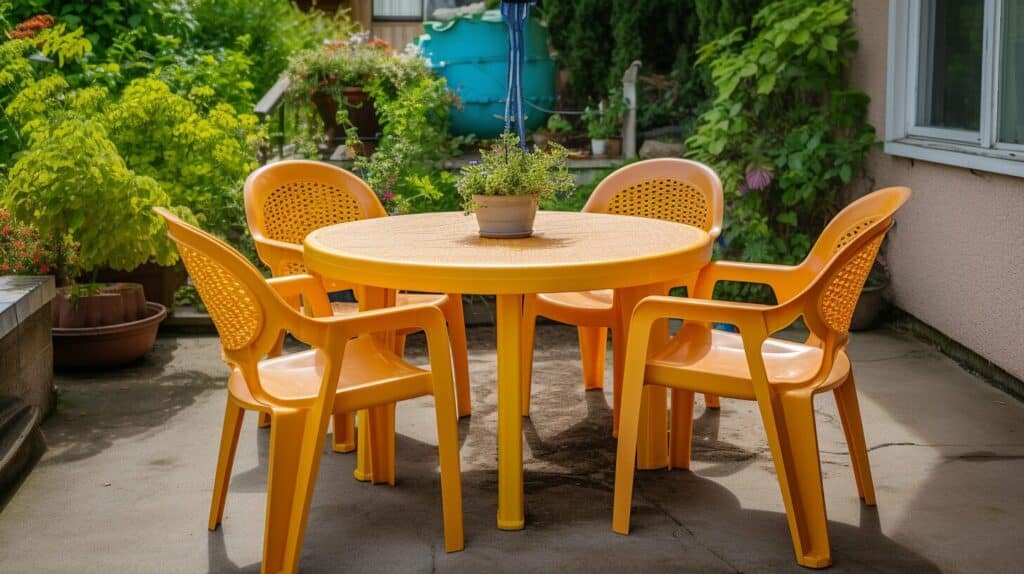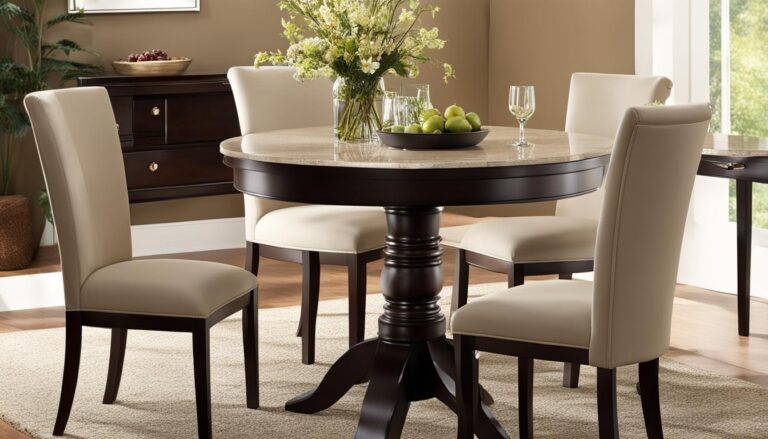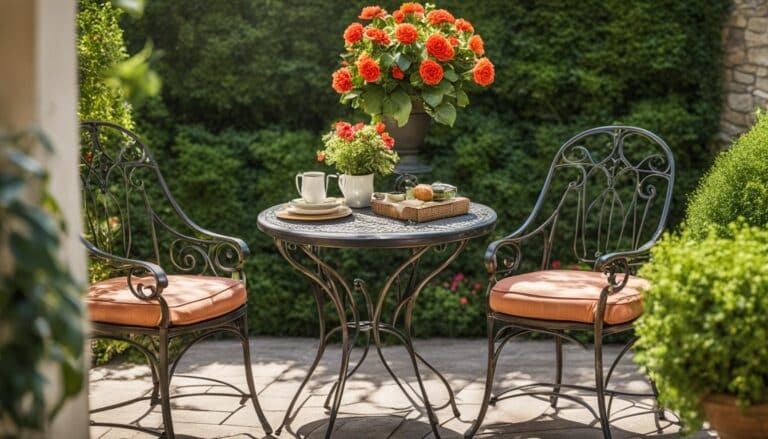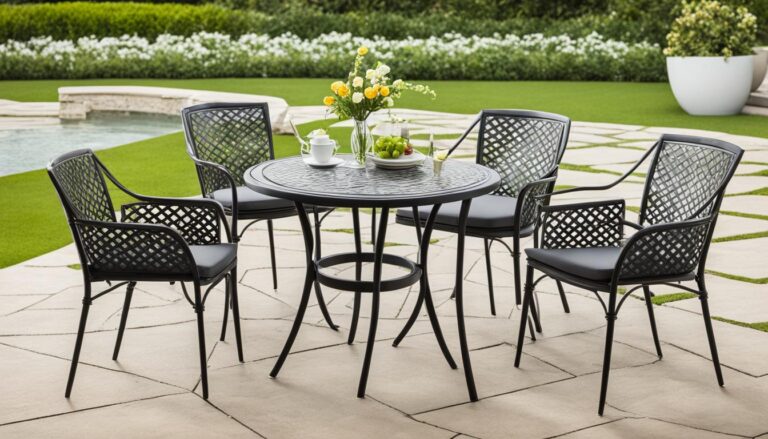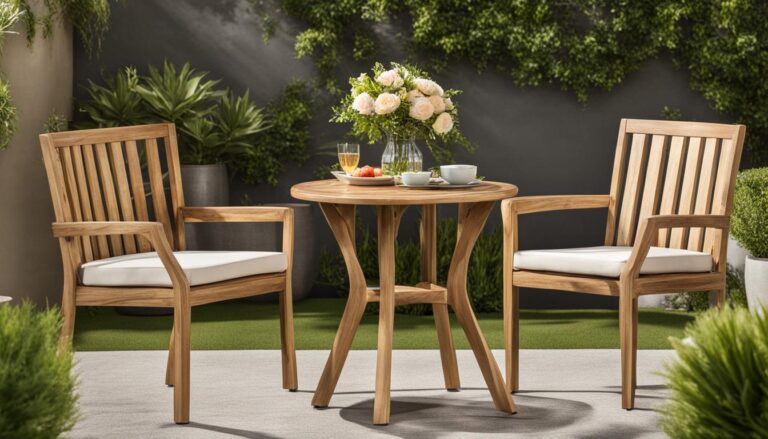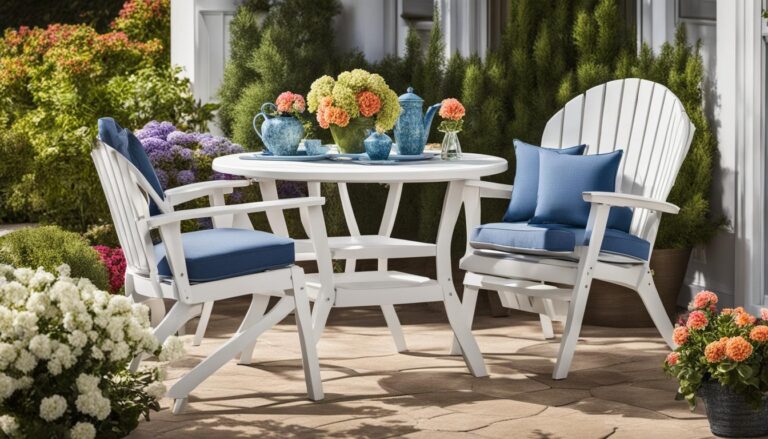Having plastic outdoor furniture is a great investment for your space. It is durable, lightweight, and affordable. However, over time, it can start to look dull and dirty, especially after being exposed to different weather conditions. Regular cleaning is essential to keep your plastic furniture looking fresh and vibrant. In this article, we’ll guide you on easy steps and tips for cleaning plastic outdoor furniture.
Key Takeaways:
- Regular cleaning is vital for maintaining the appearance of plastic outdoor furniture.
- Gather the necessary supplies before cleaning.
- Prepare the furniture surface before cleaning.
- Use safe and effective cleaning solutions.
- Properly drying and polishing the furniture after cleaning is crucial.
- Maintain and protect plastic furniture for longer durability.
- Alternative methods and products can also be used for cleaning.
- Store plastic furniture properly during the off-season.
Gather the Necessary Supplies
Before you begin cleaning your plastic outdoor furniture, it’s important to gather all the necessary supplies. This will save you time and prevent the need for multiple trips to the store. Here are some plastic outdoor furniture cleaning tips to help you:
| Supplies | Why You Need Them |
|---|---|
| Bucket of warm water | For soaking and rinsing off the furniture |
| Dish soap or gentle cleaning solution | To break down dirt and stains on the surface |
| Sponge, soft-bristled brush or cloth | To scrub and clean the surface |
| Soft-bristled brush or toothbrush | To clean in hard-to-reach areas and remove dirt from crevices |
| Vinegar and baking soda (optional) | To remove tough stains and odors |
| Protective gloves (optional) | To protect your hands from cleaning products and prevent skin irritation |
By having these supplies on hand, you’ll be able to clean your plastic outdoor furniture with ease. You can also use other outdoor furniture cleaning hacks to make the process even simpler, such as using a pressure washer or a handheld steam cleaner.
Preparing the Furniture for Cleaning
The first step in cleaning your plastic outdoor furniture is to prepare it for the process. Before applying any cleaning solution, remove debris and dirt from the surface of the furniture. Use a soft-bristled brush or a clean cloth to remove loose particles from the furniture.
If you notice any stains or spots, remove them using a wet cloth or sponge. Make sure to use only water at this stage, as using cleaning solutions on stains that could be removed with water alone might cause damage to your furniture.
Once the surface of the furniture is free of loose particles, prepare your cleaning solution. Refer to Section 4 for recommendations on choosing the right cleaning solution for your plastic furniture.
After you’ve prepared your cleaning solution, apply it liberally to a small section of the furniture using a soft-bristled brush or a sponge. Rub the solution gently over the surface of the furniture, paying extra attention to heavily stained or dirty areas. Repeat the process for the entire furniture surface.
Once you’ve applied the cleaning solution to the furniture surface, allow it to sit for at least 10 minutes. This will give the solution time to break down dirt and grime, making it easier to clean.
Choosing the Right Cleaning Solution
When it comes to cleaning plastic outdoor furniture, it’s important to choose the right cleaning solution for the job. Not all cleaning products are safe for all types of plastic, and using the wrong solution could result in damage to your furniture.
Tip: Always follow the manufacturer’s recommendations for cleaning and maintenance of your plastic furniture.
| Type of Plastic | Recommended Cleaning Solution |
|---|---|
| Polyethylene (PE) | A solution of water and mild detergent |
| Polystyrene (PS) | A solution of water and mild detergent or a diluted all-purpose cleaner |
| Polypropylene (PP) | A solution of water and mild detergent or a diluted all-purpose cleaner |
| Acrylic (AC) | A solution of water and mild detergent or a specialized acrylic cleaner |
| Polyvinyl Chloride (PVC) | A solution of water and mild detergent or a specialized PVC cleaner |
Tip: Always test the cleaning solution on a small, inconspicuous area of the furniture before applying it to the entire surface.
Alternative Cleaning Solutions:
If you prefer to use natural or DIY cleaning solutions, there are several options:
- A solution of equal parts water and white vinegar
- A solution of water and baking soda
- A solution of water and lemon juice
Tip: As with any cleaning solution, test these on a small area first.
Cleaning the Furniture Surface
Now that your plastic outdoor furniture is prepared for cleaning, it’s time to start cleaning the surface. Follow these simple steps:
- Begin by rinsing the furniture surface with a hose to remove loose dirt and debris.
- Mix a cleaning solution by mixing water and a gentle detergent in a bucket.
- Using a soft-bristled brush or a sponge, scrub the furniture surface with the cleaning solution.
- Focus on any areas that have stubborn stains or grime, and scrub gently until the stains begin to fade.
- Rinse the furniture surface thoroughly with a hose to remove all the cleaning solution.
- If necessary, repeat the cleaning process until the furniture is completely clean.
Remember to work on one section of the furniture at a time and to rinse each section before moving on to the next one. This will prevent the cleaning solution from drying and leaving streaks on the furniture surface.
Pro tip: for hard-to-reach areas, use a toothbrush or a cotton swab to gently clean the surfaces.
Treating Stubborn Stains
Some stains on plastic outdoor furniture can be particularly stubborn to remove. Here are some expert tips to help:
Ink stains:
If you have ink on your plastic furniture, try using rubbing alcohol. Soak a cloth in rubbing alcohol and gently rub the stain. Be sure to rinse the area thoroughly with water and dry completely.
Grease stains:
To remove grease stains, mix dish soap with warm water and apply to the affected area. Let the solution sit for a few minutes before wiping it away with a cloth. Repeat as necessary until the stain is gone.
Mold and mildew:
Mold and mildew can grow on plastic furniture if it’s stored in a damp area. To remove it, create a solution of equal parts white vinegar and water and spray it on the affected area. Let it sit for 15 minutes before scrubbing the area with a brush. Rinse the area with water and dry completely.
Remember to test any cleaning solution on a small, inconspicuous area of the furniture before applying it to the entire surface. This way, you can ensure that it doesn’t cause any damage or discoloration.
Drying and Polishing the Furniture
After cleaning your plastic outdoor furniture, it’s important to dry it thoroughly to prevent water spots and streaks. Use a clean, dry cloth or towel to wipe down the furniture, paying special attention to any creases or hard-to-reach areas.
For an extra polished finish, you can apply a plastic polish or wax to the furniture. These products will protect the surface from future stains and UV damage while also giving it a vibrant shine.
| Materials Needed: | Steps: |
|---|---|
| Plastic polish or wax |
|
When applying polish or wax, always follow the manufacturer’s instructions and test a small, inconspicuous area first to ensure compatibility with your specific furniture type.
Maintaining and Protecting Plastic Furniture
To ensure your plastic outdoor furniture stays looking its best, it’s important to regularly maintain and protect it. Here are some expert tips to keep in mind:
- Regular cleaning: Schedule a regular cleaning routine for your plastic furniture, especially after it has been exposed to the sun or rain. This can prevent the buildup of dirt, debris, and stains that can be difficult to remove later on.
- Use a cover: If you’re not using your plastic furniture, consider covering it with a tarp or protective cover to shield it from harsh weather conditions.
- Avoid harsh chemicals: When cleaning your plastic furniture, avoid using harsh chemicals that can damage the surface. Stick to mild dishwashing soap and warm water or a recommended cleaning solution.
- Protect from the sun: Prolonged exposure to the sun’s UV rays can cause plastic furniture to fade and become brittle. Consider applying a protective spray or wax to keep the furniture looking vibrant.
- Store properly: When storing your plastic furniture during the off-season, make sure to clean it thoroughly and disassemble it, if possible. Store it in a dry and cool place with sufficient ventilation to avoid mold and mildew buildup.
Following these simple tips can help extend the life of your plastic outdoor furniture and keep it looking new for years to come.
Cleaning Other Plastic Furniture Items
Now that you’ve mastered the art of cleaning plastic outdoor furniture, it’s time to tackle other plastic items in your yard. Here are some tips for cleaning plastic garden decor, planters, and outdoor storage containers:
| Item | Cleaning Method |
|---|---|
| Garden Gnomes, Flamingos, and Other Decor | Wipe down with a damp cloth and mild soap. For tough stains, use a plastic-safe cleaner and a soft-bristled brush. Rinse with water and dry thoroughly. |
| Planters | If your plastic planters have soil or plant residue, scrub with a plastic-safe cleaner and a soft-bristled brush. For general cleaning, wipe down with a damp cloth and mild soap. Rinse with water and dry completely before adding new plants. |
| Outdoor Storage Containers | Empty the container and remove any debris or dirt. Wipe down the inside and outside with a damp cloth and mild soap. Rinse with water and dry thoroughly before using again. |
Remember to always check labels and follow manufacturer instructions when using cleaning products or tools on plastic items. With these tips, your entire yard will be looking clean and refreshed.
Alternative Methods for Cleaning Plastic Furniture
If you’re looking for alternative methods for cleaning your plastic outdoor furniture, try these tips:
- Baking Soda: Mix baking soda and water to create a paste, then apply it to the furniture with a soft cloth. Rub gently and rinse with water.
- Vinegar: Mix equal parts of vinegar and water and use a spray bottle to spritz the furniture. Let it sit for a few minutes, then wipe with a damp cloth.
- Lemon Juice: Mix lemon juice and water, then apply the mixture to the furniture with a sponge. Let it sit for a few minutes, then rinse with water.
- Dish Soap: Mix a small amount of dish soap with warm water and use a sponge to clean the furniture. Rinse with water and dry with a clean cloth.
These methods are safe and effective for removing dirt, stains, and grime from your plastic furniture. Try them out and see which one works best for your needs.
Storing Plastic Furniture During Off-Season
When the off-season arrives, it’s important to properly store your plastic outdoor furniture to protect it from damage and extend its lifespan.
Start by cleaning the furniture thoroughly, following the steps and tips outlined in this article. Once it’s clean and dry, disassemble any parts that can be taken apart, such as legs and arms, to make it easier to store.
Next, choose a dry and covered area for storage, such as a garage or shed. Avoid exposing the furniture to direct sunlight or moisture, which can cause fading, warping, and mold growth.
If space is limited, consider using furniture covers or storage bags to protect the pieces from dust and debris. Make sure to secure the covers or bags tightly to prevent them from blowing away or shifting during windy weather.
Finally, periodically check on the furniture during the off-season to ensure it’s not experiencing any damage or moisture buildup. With proper storage, your plastic outdoor furniture will be ready to use again when the weather warms up.
Conclusion
Congratulations, you’ve successfully cleaned and polished your plastic outdoor furniture! By following these easy steps and tips, you’ve ensured that your furniture will look great and last for years to come. Remember to clean your furniture regularly and protect it from harsh weather conditions to maintain its longevity.
Don’t forget to also apply these techniques to other plastic items in your outdoor space, such as garden decor and storage containers.
If you’re looking to switch up your cleaning routine, consider trying out some of the alternative methods and products suggested in this article. And when the off-season arrives, be sure to properly store your furniture to keep it in tip-top shape.
We hope this article has been helpful in guiding you through the process of cleaning and maintaining your plastic outdoor furniture. Happy cleaning!
FAQ
Q: How often should I clean my plastic outdoor furniture?
A: It is recommended to clean your plastic outdoor furniture at least once a month to prevent dirt and grime buildup.
Q: What supplies do I need to clean plastic outdoor furniture?
A: Gather the following supplies: warm water, mild soap or detergent, a soft brush or sponge, a bucket, and a garden hose.
Q: Can I use bleach to clean plastic outdoor furniture?
A: It is best to avoid using bleach on plastic furniture as it can cause discoloration and damage. Stick to mild soap or detergent instead.
Q: How do I remove stains from plastic outdoor furniture?
A: To remove stains, create a paste using baking soda and water. Apply the paste to the stained area, gently scrub, and rinse with water.
Q: Can I use a pressure washer to clean plastic furniture?
A: It is not recommended to use a pressure washer on plastic furniture as it can cause damage. Stick to gentle cleaning methods using a soft brush or sponge.
Q: How do I protect my plastic outdoor furniture from the sun?
A: To protect your plastic furniture from the sun, you can use a UV-resistant furniture cover or keep the furniture in a shaded area when not in use.

